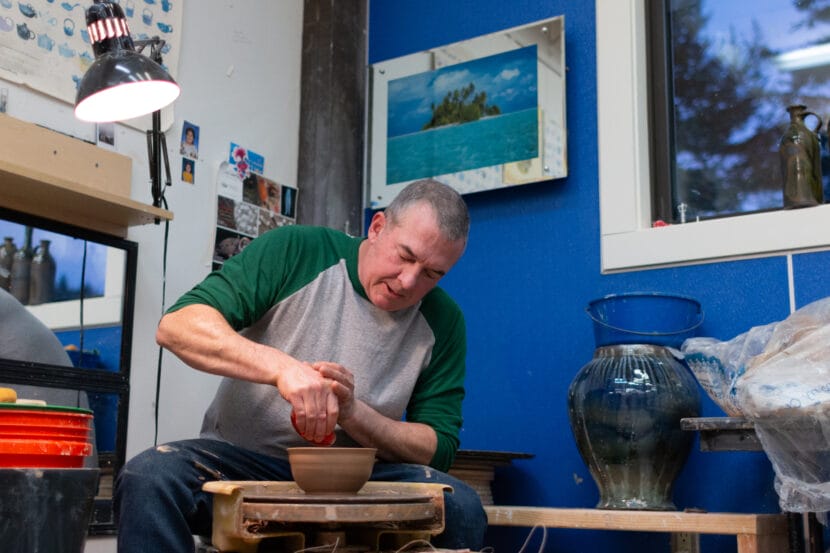
This is Tongass Voices, a series from KTOO sharing weekly perspectives from the homelands of the Áak’w Kwáan and beyond.
The University of Alaska Southeast’s ceramics classes in Juneau are hard to get into — because so many people want to take them.
Jeremy Kane has been teaching ceramics for 20 years. Each year, the ceramics department makes and donates hundreds of bowls to the Empty Bowls fundraiser, which raises money for the Glory Hall shelter in Juneau. This year’s fundraiser is on Sunday.
KTOO sat in on a bowl-making demonstration in his intermediate class at UAS.
Listen:
This transcript has been lightly edited for clarity.
Speaking to his class: But we’re going to start with about a couple of pounds of clay, maybe a little bit more — two-and-a-half, two-and-a-quarter. It’s not really so important how you make it was just a matter of being efficient with your operation.
And when I put this clay on the wheel, there’s no need to show off. Make that nice round ball of clay, getting your hands smacking around a little bit. This clay is going to soften up so much.
Center it, and enter it. If the clay is wedged properly, shouldn’t have to do too much centering, shouldn’t have to do too much work at all.
Interview transcript: My name is Jeremy Kane. I moved to Fairbanks when I was 18 years old with my friends, and I had taken ceramics classes as a kid, so I’ve been making things for a long time. So I took college ceramics starting when I was 18 in Fairbanks. Then I have a master’s degree from Ohio University. That’s when I finally landed this position here, and I’ve been working here ever since. So it’s my 20th year teaching.
To class: I encourage you guys to try to set some goals for timing on these pots. We had like a race in grad school one time, I think I made 45 bowls in an hour. All the clay was prepped, not talking to anybody, you just sit there and go knock them out. And then later, you got to trim them.
So I wouldn’t go to that extent, but I think that you guys should all easily be able to make 10 bowls. I mean, easy.
Interview: This particular project, we do it for the homeless shelter in town, and we’ve been doing it for years. We’ve donated thousands of bowls to this particular project over the years. But I don’t want it to be just a donation. I want the students to be able to learn from it.
To class: Part of a nice handmade bowl has to do with the fact that you still have a hand in it. Okay, so some of the nicest pots you’ll buy, that are actually commercial pots, like say from China. They all have reference of hand marks in them, because that’s what people like.
You can see there’s a little undulation in that pot. Undulation means it’s got a little wiggle to it. When I make pots, I like to have that motion in there. Or else I can just buy them at Kmart. You guys probably don’t know what Kmart is anymore.
Interview: I try to encourage them to do it different ways, different styles of bowls and different techniques. So itʼs not necessarily like one standard bowl you crank out, I want them to really think about it.
To class: You know, when you think about bowls, like for this particular project, I want you guys to like — we’re not just donating time. I want you guys to think about things — and it sounds selfish, but when you’re making pots, you gotta make them for yourself. If they’re nice enough for you, then they get really evenly distributed throughout the community, essentially. Okay, so you don’t make things for other people, you make them for yourself. Because you’re the artist, you’re the person who spends the time doing it. But you gotta make something that you like.
Interview: I do think that making things in multiples is the only way to learn how to make pottery. You know, it’s kind of the art of repetition.
To class: But when it comes to making pots, sometimes it’s nice to have a bigger, bigger bowl. You want room in that bowl to be able to put stuff. So if you’re serving somebody dinner and you have this really tiny little bowl that you made, you’re real proud of it. Maybe it’s better to put like jelly or like put some sort of dip in there or something.
But a real bowl would have enough room that you could serve food and still have like two or three inches on the top of that pot in order to be able to look at the surface on that ceramics, or to be able to see what it is, or it creates a contrast between the food.
Say you’re eating some sort of crab bisque. Right? Oh my God, that sounds killer. Did anybody bring that tonight for class? I wish you did.
So many cultures have that sort of specialty, different foods and different spices, but it’s all food. People make potatoes, meat and vegetables. That’s the world. It’s not that amazing. But the dishes that the stuff is served in, I think, make it amazing.
Okay, alright, get to work.



